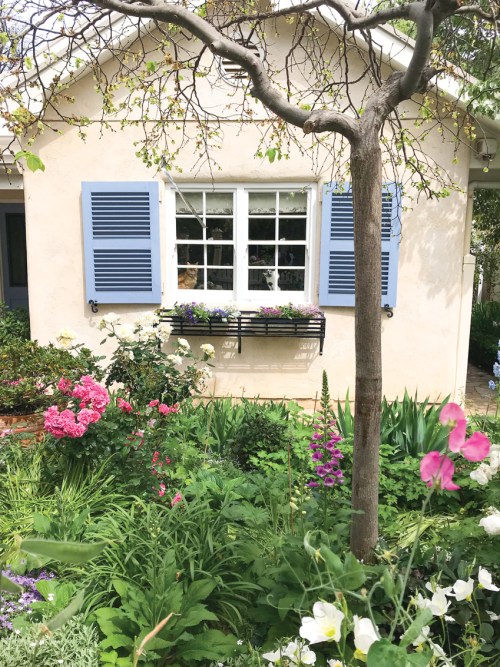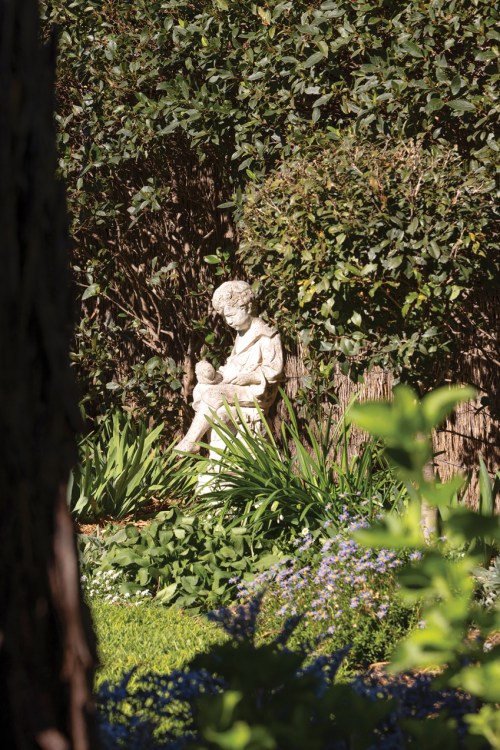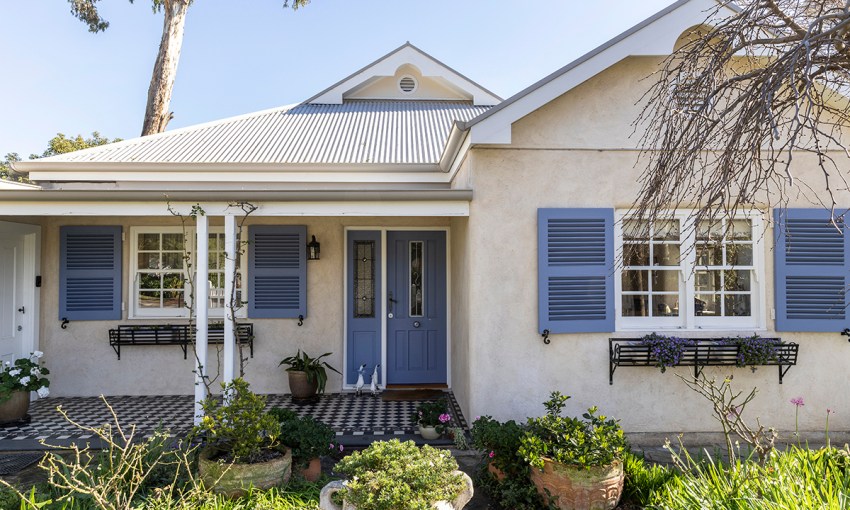There is no luck involved with maintaining a European-inspired garden in Australia – it is Deb Worthley’s hard work and sustainable lifestyle that allow this Leabrook garden to flourish.
Cottage to the core
Crabapple Cottage looks like something pulled from a European fairytale and placed into the real world – a perfect white picket fence, dainty flowers sprawling from garden to footpath and a quaint cottage with French blue shutters and a door to match.
Iris, lavender, alyssum, dwarf bougainvillea and white roses bloom on both sides of the footpath outside the property.
Stepping through the gate down to a circular path, where low drystone walls hug both sides and the plants cascade over their edges, creating a whimsical entrance.
The surrounding garden beds are meadows of pink, white, mauve, purple and blue – planted thickly with geranium silverbush, hellebores, catmint, seaside daisy, alyssum, asters and blue marguerite daisies.
Colourful hollyhocks, miniature agapanthus, irises, pincushions, society garlic and foxgloves poke their heads above the clustered foliage while miniature cyclamen, bellflowers and society daisies blossom in the undergrowth.
The beautiful crabapple tree – the garden’s namesake – sprouts from the centre of this luscious garden bed.


An urn filled with colourful calibrachoa sits in the middle of the pathway, drawing the eye to the centre of the front yard and the cottage beyond.
Deb Worthley purchased the land from her neighbours after they subdivided their block and was inspired to build her dream home and garden.
“Because I am passionate about living sustainably, I wanted a house of low-embodied energy and decided to build a strawbale house,” Deb says.
“The strawbale walls have amazingly effective insulation and, when the house is past its use-by date, they can be composted.”
In 2007, the cottage was completed and Deb spent a year laying down the garden’s bones before planting commenced.
Winding footpaths and small retaining walls were crafted using recycled bluestone and red bricks given to Deb by her sister who had leftovers from recent construction at her place.


“That gave me the foundation to begin because I could see where the beds would go,” Deb says.
“I knew I wanted a cottage garden because I love the unplanned, natural look and variety of plants you can get away with.
“You can tidy up this style with mild formalities like paths and small hedges, and I feel that as long as there is harmony in the colour scheme it will work.”
To establish her garden, Deb recruited the help of professional garden designers, but nothing she was presented with suited her vision. Sharing her woes with a friend, they told her she didn’t need a professional gardener, she could do it herself – and so she did.


“The garden has mostly been a process of finding things I like, popping them in and watching it all come together,” Deb says.
“I made some mistakes, but that’s all part of the experience.”
Pencil pines line the side fences where Deb has established a predominantly white and green garden of iris, summer snowflakes (Leucojum aestivum), bellflowers and miniature cyclamen bordered by box hedges.
“White and green look so lovely together and you can vary the textures and the heights of the plants to create interest in the garden,” Deb says.


A small goldfish pond sits within this garden, backed by a diamond espaliered star jasmine and surrounded with flowering pear, silver birch and three Japanese maples.
The heart of the back yard is Deb’s organic vegetable garden where she grows everything from strawberries and citrus to zucchini and broccoli.
“Last year, I picked almost 23 kilograms of strawberries over the season,” Deb says. “I was making lots of jam and coulis which sold at Open Gardens and kept me out of mischief.”
The garden is home to many productive fruit trees that provide Deb with an abundance of lemons, oranges, limes, apricots, peaches, passionfruit, apples and avocadoes each year.


Deb included a small patch of lawn to create a void between garden beds and prevent the garden from looking overcrowded.
“Nearby, I planted a beautiful gingko tree,” Deb says. “It is said that you plant gingko trees for the next generation as they are such slow growers, you probably won’t see their full beauty during your lifetime.”
Beneath a graceful weeping elm (Ulmus glabra Camperdownii), an ornate iron-work pergola sits surrounded by the garden’s beauty – offering a space to unwind in the sunshine and enjoy the sounds of the pond’s trickling water and birds in the trees.
“I don’t spend enough time out there relaxing – whenever I try, I always notice something to do and end up working in the garden.”


Deb acknowledges that planting a native garden would have been better for the climate, but she has always loved European gardens and is continuously finding new, sustainable ways to compensate for the garden’s style.
At the property’s rear, Deb has established a utility area where she has two water tanks, compost bins, a worm farm and a rotating mulch pile.
“I run the house and garden completely off the water tank during wetter months, and get at least four waterings from the tank during summer. I also put down plenty of mulch and use homemade organic compost and worm castings to improve the soil’s quality and water retention,” Deb says.
“When I first moved in, people would see me outside sweeping up the street’s autumn leaves. One day, a lady came up to me and thanked me for tidying up the street and I had to tell her I was doing it to gather leaves for mulch, not just because I was being a good Samaritan.”

The garden’s great plant diversity attracts beneficial insects, which in turn reduces Deb’s need for pesticides and encourages native wildlife.
“Ever since frogs moved into the pond, I haven’t seen a single snail because they love eating them.
“There is also a resident magpie who often comes into the garden and visits when I am outside. Sometimes when I am gardening, I dig up huge grubs and will put them in a spare pot with soil so when she comes by, I can feed them to her, which she loves.”
With the garden full to the brim, Deb has no concrete plans to continue expanding, but says a gardener’s work is never truly done.
“You change and look after things so the garden can flourish and do its best.
“I love the connection with nature and the simple joys of watching plants you really love grow, bloom and flourish.
“It doesn’t always look brilliant, but I do the best that I can and it is a beautiful living and changing tapestry – I really appreciate what I have got.”
This article first appeared in the Spring 2023 issue of SALIFE Gardens & Outdoor Living magazine.



